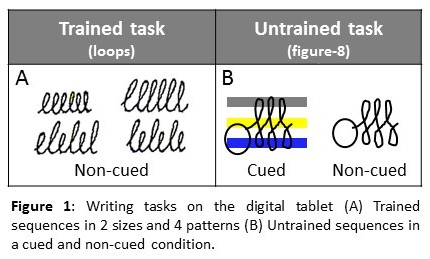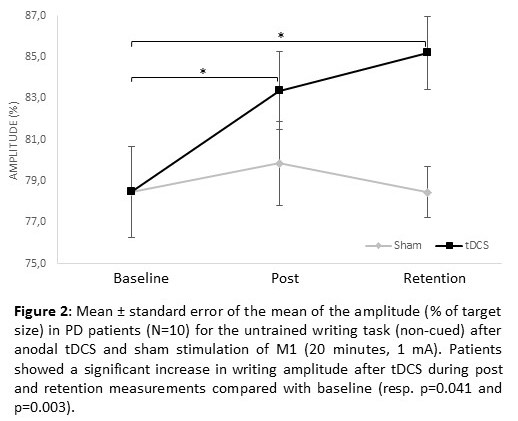Session Information
Date: Thursday, June 8, 2017
Session Title: Parkinson’s Disease: Clinical Trials, Pharmacology And Treatment
Session Time: 1:15pm-2:45pm
Location: Exhibit Hall C
Objective: To examine the effects of training combined with transcranial direct current stimulation (tDCS) on writing performance and consolidation of learning in Parkinson’s disease (PD).
Background: Rehabilitation can improve motor impairments in PD patients, albeit for a limited period. Compared with healthy controls, learning efficiency of sequential motor learning and consolidation is reduced in PD. Recent research has highlighted the potential of tDCS to complement and enhance neuroplasticity and learning in patients with neurological diseases, including PD patients.
Methods: Ten PD patients (ON medication state) and 10 age-matched controls received 2 sessions of writing training on a digital writing tablet combined with 20 minutes of 1 mA anodal tDCS or sham on the left primary motor cortex in a randomized cross-over design with a 3-week washout period. Writing skills on the tablet and paper were assessed at baseline, after training and after a 1-week retention period. Tests on the tablet included writing of trained and untrained sequences to assess transfer (figure 1). Writing on paper included the ‘Systematic Screening of Handwriting Difficulties’ (SOS-test).
[figure1]
Results: No tDCS effects were found for the amplitude (% of target size) of the trained task. For the amplitude of the untrained task significant Time x Stimulation interactions were found for both the cued and the non-cued condition (resp. p=0.009 and p=0.019) showing an increased writing size after tDCS, regardless of group. Sub-analysis per group revealed for the PD patients a significant Time x Stimulation interaction for the amplitude of the non-cued condition of the untrained task (p=0.038), which was not found in controls. Post-hoc analysis showed for PD a significant improvement after tDCS during the post and retention measurements compared to baseline (resp. p=0.041 and p=0.003) (figure 2). No improvements were found after sham stimulation. TDCS effects were also not apparent during transfer measured with the paper test.
Conclusions: These results suggest that tDCS combined with training improves the transfer of a learned writing task to a novel one, specifically for PD patients performing in a non-cued setting. However, transfer to real life writing did not occur. These findings warrant further study during prolonged training to investigate the potential of tDCS to enhance consolidation in PD.
[figure2]
To cite this abstract in AMA style:
S. Broeder, E. Nackaerts, E. Heremans, K. Cuypers, R. Meesen, G. Verheyden, A. Nieuwboer. Transcranial direct current stimulation enhances consolidation of learning in Parkinson’s disease [abstract]. Mov Disord. 2017; 32 (suppl 2). https://www.mdsabstracts.org/abstract/transcranial-direct-current-stimulation-enhances-consolidation-of-learning-in-parkinsons-disease/. Accessed October 17, 2025.« Back to 2017 International Congress
MDS Abstracts - https://www.mdsabstracts.org/abstract/transcranial-direct-current-stimulation-enhances-consolidation-of-learning-in-parkinsons-disease/


